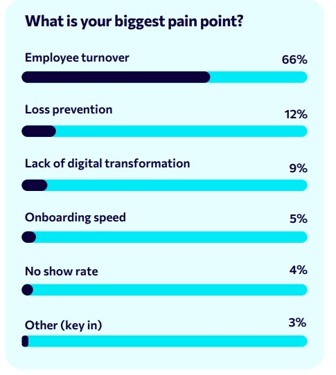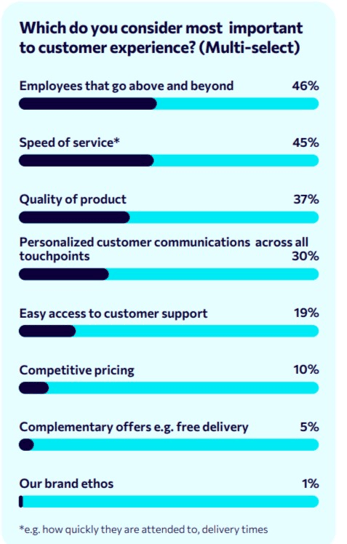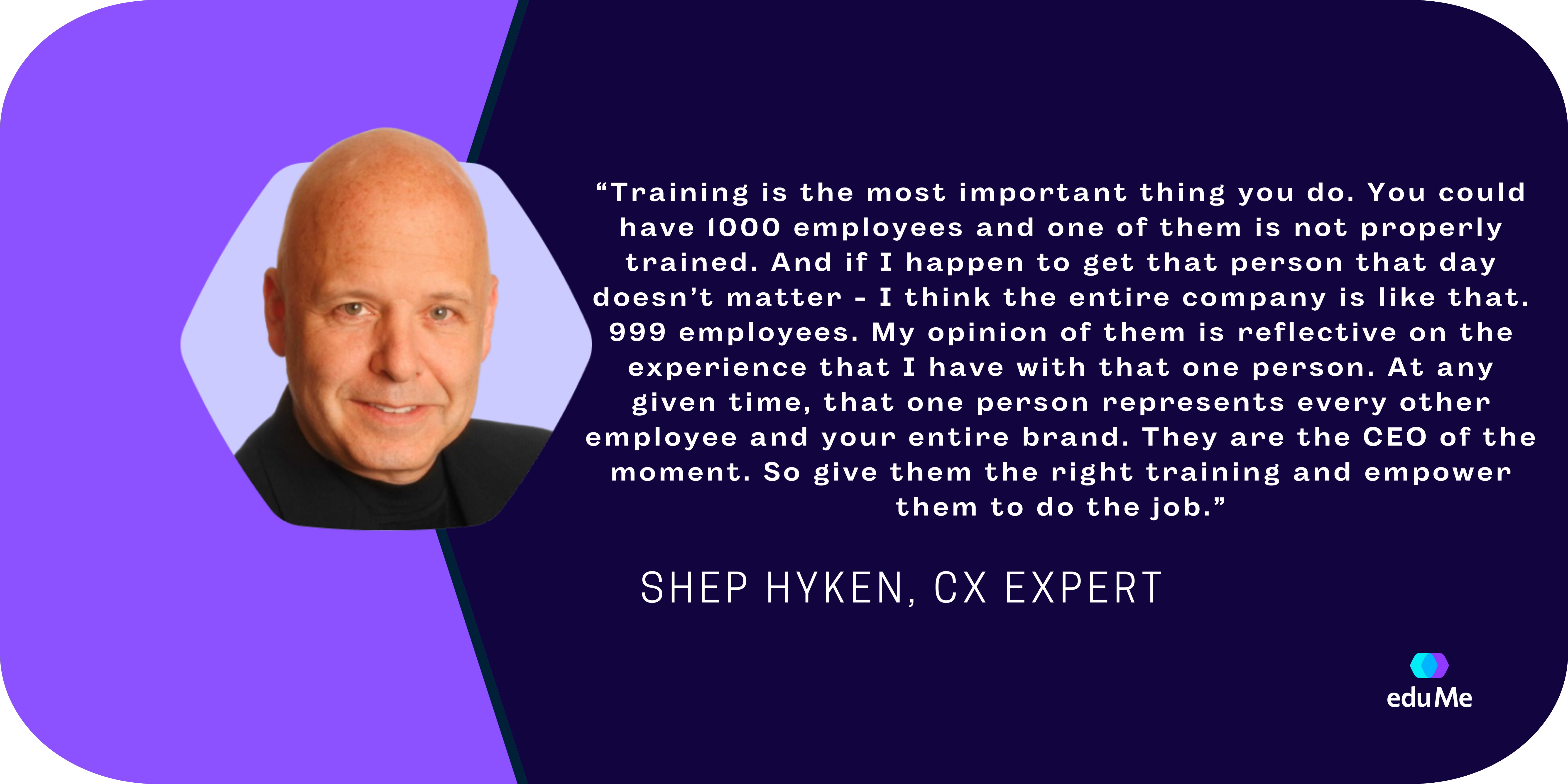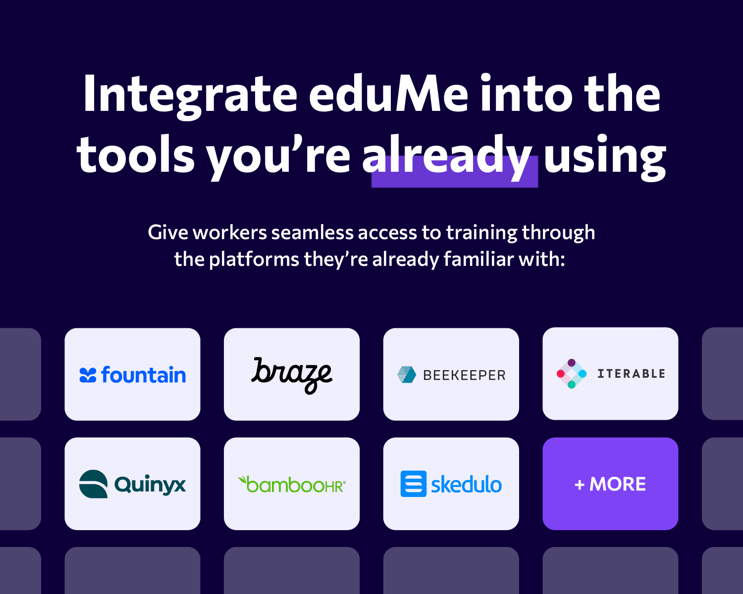In August 2023, we surveyed over 300 individuals at the General Manager level within the retail and hospitality industry. From their responses, we identified key trends for 2024 that include pain points, challenges, and determining what’s most important to these organizations heading into next year.
We also looked at steps managers are taking to optimize key business areas, and how some of their current practices are preventing them from reaching their goals.
So, without further ado, here are the key trends you need to know about.
Quick Navigation:
- Challenges Facing Retail & Hospitality leaders in 2024
1. Employee turnover
2. Improving customer experience
3. Increasing sales - How leaders can resolve current challenges
- Easy opportunities for training optimization
1. In-person vs online
2. Session length
3. Device optimization
4. Software interconnectivity
5. Training format
What is Challenging Retail & Hospitality Leaders in 2024?
Pain points and focus areas for 2024
Retail and hospitality experienced significant change over the last few years, resulting in the birth of new pain points and the re-evaluation of focus areas. That's not to say historic problems have gone away, in fact, recent events have only exacerbated the all-too-familiar issues that keep both industries up at night.
Let's get into what we found.
1. Employee turnover
For those of you who follow our blogs, finding employee turnover at the top of the list is unsurprising. Retaining talent has proven difficult for both the retail and hospitality industries in recent years with low wages, unfavorable working hours, and questionable business values contributing to a burgeoning dissatisfaction among workers. ‘The Great Resignation’ of 2021 was the devastating outcome of this unsustainable working environment.

But don’t let that label fool you— mass resignations didn’t end in 2021, and they continue to keep business owners up at night. In fact, 66% of GMs put employee turnover at the top of their pain point list, with loss prevention a distant second at 12%.
2. Improving customer experience
With employee turnover listed as the biggest problem facing R&H managers, it’s logical to assume that retaining talent would top the list of what businesses deem the most important in 2024.
However, retaining talent had to settle for second place as it was improving customer experience (CX) that took the top spot as leaders' biggest focus area.
And no surprise, given today’s consumers are characterized by their demand for a personalized experience.
No longer satisfied with quality products at competitive pricing, they want a holistic experience that meets their needs at every touchpoint. With business success dependent on the customer, it explains why improving CX tops the list.
How to improve CX
Customer experience is made up of many different components, from support team response times to the atmosphere in a store. Despite this, one common theme among leaders was what they perceived to make the biggest difference to a customer's experience, and it was their employees.

Employees who go above and beyond polled as most important by 46% of businesses, marginally beating speed of service, and then outranking quality of product by 9% and personalization by 16%.
Surprising? We think not. Not only are employees the face of your business, they’re also responsible for delivering the other key elements of CX including the ones mentioned above.
Considering the belief that it was employee performance that moved the needle on customer experience, it was no surprise that leaders advocated for employee training as the best way to optimize CX.
However, despite understanding the value of an effective workforce, many leaders lacked confidence in their current team, citing high employee turnover (65%) and a lack of relevant knowledge (18%) as reasons why their workforce consistently fails to deliver an exceptional experience.
|
We met with CX Expert Shep Hyken to discuss some of our findings. Check out what he had to say about the importance of experience to the customer of today 👇 |
3. Increasing sales
At a time when inflation and operating costs are at an all-time high, it’s hardly surprising to see leaders isolate sales as a major area of focus.
In terms of what leaders deemed most important, improving sales metrics finished level (23%) with employee retention and just behind improving customer experience. In truth, all three are dependent on each other—sales are driven by a great customer experience, and a great experience can only be delivered by a present and effective workforce.
There are creative strategies businesses can employ to increase sales that range from optimizing store layout to enhancing customer reviews.
But the overarching message here is the same one that applies to all the other trends that we’ve identified: your employees are the heart and soul of your operation. It's why employee retention and improving customer experience outranks sales—an increase in sales is the result of a skilled workforce.
How can Retail & Hospitality leaders resolve current challenges?
We’ve identified key challenges and pain points within the retail and hospitality industries and shone a light on what leaders consider most important to their businesses.
Now it’s time to see what organizations are currently doing to drive themselves towards their goals, and equally, what they’re doing that’s detrimental to their business.
Employee training
Training is a top priority among those surveyed, with 93% reporting that they administer training.
Clearly, the correlation between employee training and improved business performance is not lost on leaders. And more importantly, for many of those surveyed, training is not just a one-time thing. 24% report administering daily training, 26% do so weekly, and less than 1% report limiting training to an annual event.
Continuous training is especially crucial for industries like retail and hospitality where inventories, technologies, and sales strategies are ever-changing.
However, we must consider the quality of training as well as quantity. It’s great employees are receiving training, but is it really helping them?

Opportunities for optimization
At one point in the not-so-distant past, a significant portion of frontline workers failed to receive any formal training whatsoever. It's therefore a significant achievement that almost all retail and hospitality leaders now administer some kind of training.
However, we identified key issues across both industries with the training currently on offer and discovered areas that could easily be optimized with just a few simple changes.
1. In-person vs online
Despite living in the digital age, 92% of retail & hospitality leaders conduct training face-to-face, compared to 8% training digitally. While this does have some advantages, they are far outweighed by its limitations.
Retail and hospitality workers are always on the move, working a variety of shift patterns and inconsistent hours. They are, by nature, very hard to reach, and the only effective type of training accounts for all of this.
Face-to-face training is costly, timely, and requires the removal of workers from their roles. It directly costs the business money, and its typical classroom format is not conducive to engagement and knowledge retention.
2. Length of session
The opportunity cost of time spent training is productivity loss. When your workers are off the shop floor and away from their roles, the business is losing money. Ideally, businesses want to minimize time spent training while maximizing training results. However, 39% report that training sessions last more than a day, and 37% report a few hours.
We now have a significant portion of retail & hospitality leaders administering face-to-face training that lasts, at the very least, a couple of hours.
3. Device optimization
You won’t receive the benefits of digital employee training without device optimization. Of the 8% who administer training digitally, 55% are doing so via desktop and mobile, 41% on desktop alone, and just 5% via mobile app alone.
With using a desktop device for frontline workforces, you’re still experiencing the same problems as in-person training which is relocating workers from the shop floor and reducing productivity. It’s also likely that businesses won’t have one desktop per employee, creating scarcity - employees can’t access training in the moment of need, but when the device is available.
4. Software interconnectivity
Of those who are leveraging a digital solution for employee training, 62% use them as a separate app.
Why is this a problem? In simple terms, the more difficult it is to access something, the less likely you are actually to access it. Running training via a separate app instead of integrating it into existing work tools means employees must jump through several hoops before arriving at their training.

Downloading the app, inputting login information, remembering passwords, updating apps, etc.— these extra steps cause unnecessary friction and guarantee a loss of motivation.
Fortunately, leaders seem to be aware of this problem, with 24% reporting a desire to make training more accessible.
5. Training formats
You’ve adopted accessible, regular mobile training to upskill your workforce. You seem to be doing everything right yet your employees aren’t engaging with the training. It’s time to analyze your training format.
When asked ‘what would improve engagement rates for digital training?’ 52% of leaders replied ‘training that was more fun.’
A goal of optimizing your training is to improve completion rates as these best illustrate how well your content is holding the attention of its users. Considering most R&H leaders utilize desktop learning, it’s likely they’re also rolling out long-format, information-heavy content that fails to promote engagement. In other words, it’s boring.
So, what’s considered fun? It depends on who you ask. In these industries, millennials (age 29-43) and Gen Z (age 18-28) make up a combined 79% of the workforce.
These demographics are digital natives, characterized by their short attention spans and love of social media-style content.
Leaders who want to increase engagement must therefore shape content to fit their workforce. Mobile training has the ability to utilize microlearning and create content with a familiar feel (think reel-style tutorial videos, emojis, swiping, tapping).
.gif?width=1400&height=1100&name=Guides%20AI%20GIF%20(1).gif)
For the full report, click here!
eduMe is the platform of choice for businesses looking to optimize their frontline training. By harnessing the power of microlearning and seamlessly integrating into existing work tools, we empower employees to take control of their learning and improve workplace performance. Those already partnered with eduMe have experienced a 66% increase in sales, a 79% training engagement rate, and a 10% increase in quality of service.
Get in touch with us now to find out more!






